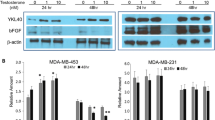Abstract
The purpose of our study was to investigate whether enterolactone does accumulate into breast cyst fluid and whether it correlates with breast cancer risk. We included 258 women who had at least one cyst aspiration and known intracystic cation and epidermal growth factor (EGF) concentration values. For 191 of such women serum aliquots were also available. The median value of serum enterolactone was 17 nM/l (range 1–140 nM/l). The median intracystic level of enterolactone was much higher (63 nM/l, range 0–872 nM/l) and was significantly higher in type I cysts (p = 0.000). This cyst type contained also significantly higher levels of EGF (p = 0.000). A direct relationship was found between serum and cyst fluid enterolactone levels (p = 0.000) and between cyst enterolactone and EGF levels (p = 0.03), the latter correlation being evident especially in type II cysts. Twelve patients in the cohort of women were found to have developed a breast cancer. After univariate analysis breast cancer risk was associated with cyst type and especially with EGF concentration. No association was evident for enterolactone concentration. However, enterolactone concentration appeared to significantly decrease the risk of patients with high EGF concentrations. Our results show that enterolactone does accumulate in breast cysts, and that it modulates the risk related to the intracystic level of EGF, which is confirmed to be a strong predictor of breast cancer risk.
Similar content being viewed by others
References
Reinli K, Block G: Phytoestrogen content of foods-a compendium of literature values. Nutr Cancer 26: 123–148, 1996
Setchell KDR, Adlercreutz H: Mammalian lignans and phytooestrogens: recent studies on their formation, metabolism and biological role in health and disease. In: Rowland IR (ed) Role of the Gut Flora in Toxicity and Cancer. Academic Press, London, 1998, pp 315–345
Lee HP, Gourley L, Duffy SW, Esteve J, Lee J, Day NE: Dietary effects on breast-cancer risk in Singapore. Lancet 337: 1197–1200, 1991
Yuan JM, Wang QS, Ross RK, Henderson BE, Yu MC: Diet and breast cancer in Shanghai and Tianjin, China. Br J Cancer 71: 1353–1358, 1995
Ingram D, Sanders K, Kolybaba M, Lopez D: Case-control study of phyto-oestrogens and breast cancer. Lancet 350: 990–994, 1997
Pietinen P, Stumpf K, Mannisto S, Kataja V, Uusitupa M, Adlercreutz H: Serum enterolactone and risk of breast cancer: a case-control study in eastern Finland. Cancer Epidemiol Biomarkers Prev 10: 339–344, 2001
Morton MS, Chan PS, Cheng C, Blacklock N, Matos-Ferreira A, Abranches-Monteiro L, Correia R, Lloyd S, Griffiths K: Lignans and isoflavonoids in plasma and prostatic fluid in men: samples from Portugal, Hong Kong, and the United Kingdom. Prostate 32: 122–128, 1997
Franke AA, Custer LJ, Tanaka Y: Isoflavones in human breast milk and other biological fluids. Am J Clin Nutr 68(Suppl 6): 1466–1473, 1998
Boccardo F, Marenghi C, Ghione G, Pepe A, Parodi S, Rubagotti A: Intracystic epidermal growth factor level is predictive of breast-cancer risk in women with gross cystic disease of the breast. Int J Cancer 95: 260–265, 2001
Boccardo F, Valenti G, Zanardi S, Cerruti G, Fassio T, Bruzzi P, De Franchis V, Barreca A, Del Monte P, Minuto F: Epidermal growth factor in breast cyst fluid: relationship with intracystic cation and androgen conjugate content. Cancer Res 48: 5860–5863, 1988
Stumpf K, Pietinen P, Puska P, Adlercreutz H: Changes in serum enterolactone, genistein, and daidzein in a dietary intervention study in Finland. Cancer Epidemiol Biomarkers Prev 9: 1369–1372, 2000
Fliess JL: Statistical Methods for Rates and Proportions. Wiley, New York, 1991
Siegel S: Non-parametric Statistics. McGraw-Hill Kogakusha, Ltd, London, 1959
Zeleniuch-Jacquotte A, Adlercreutz H, Akhmedkhanov A, Toniolo P: Reliability of serum measurements of lignans and isoflavonoid phytoestrogens over a two-year period. Cancer Epidemiol Biomarkers Prev 7: 885–889, 1998
Dixon JM, Miller WR, Scott WN, Forrest AP: The morphological basis of human breast cyst populations. Br J Surg 70: 604–606, 1983
Dixon JM, McDonald C, Elton RA, Miller WR: Risk of breast cancer in women with palpable breast cysts: a prospective study. Edinburgh Breast Group. Lancet 353: 1742–1745, 1999
Boccardo F, Torrisi R, Zanardi S, Valenti G, Pensa F, De Franchis V, Barreca A, Ferraro P, Minuto F: EGF in breast cyst fluid: relationships with intracystic androgens, estradiol and progesterone. Int J Cancer 47: 523–526, 1991
Belanger A, Caron S, Labrie F, Naldoni C, Dogliotti L, Angeli A: Levels of eighteen non-conjugated and conjugated steroids in human breast cyst fluid: relationships with cyst type. Eur J Cancer 26: 277–281, 1990
Bradlow HL, Rosenfeld RS, Kream J, Fleisher M, O'Connor J, Schwartz MK: Steroid hormone accumulation in human breast cyst fluid. Cancer Res 41: 105–107, 1981
Lai LC, Ghatei MA, Takahashi K, Patel KV, Schrey MP, Ghilchik MW, Bloom SR, James VH: Mitogenic peptides in breast cyst fluid: relationship with intracystic electrolyte ratios. Int J Cancer 46: 1014–1016, 1990
Zanardi S, Pensa F, Torrisi R, de Franchis V, Barreca A, Minuto F, Boccardo F: Presence and distribution of growth factors in breast cyst fluid. Ann NY Acad Sci 784: 542–549, 1996
Ness JC, Sedghinasab M, Moe RE, Tapper D: Identification of multiple proliferative growth factors in breast cyst fluid. Am J Surg 166: 237–243, 1993
Welshons WV, Murphy CS, Koch R, Calaf G, Jordan VC: Stimulation of breast cancer cells in vitro by the environmental estrogen enterolactone and the phytoestrogen equol. Breast Cancer Res Treat 10: 169–175, 1987
Wang C, Kurzer MS: Phytoestrogen concentration determines effects on DNA synthesis in human breast cancer cells. Nutr Cancer 28(3): 236–247, 1997
Wang C, Kurzer MS: Effects of phytoestrogens on DNA synthesis in MCF-7 cells in the presence of estradiol or growth factors. Nutr Cancer 31: 90–100, 1998
Author information
Authors and Affiliations
Rights and permissions
About this article
Cite this article
Boccardo, F., Lunardi, G.L., Petti, A.R. et al. Enterolactone in Breast Cyst Fluid: Correlation with EGF and Breast Cancer Risk. Breast Cancer Res Treat 79, 17–23 (2003). https://doi.org/10.1023/A:1023356209478
Issue Date:
DOI: https://doi.org/10.1023/A:1023356209478




